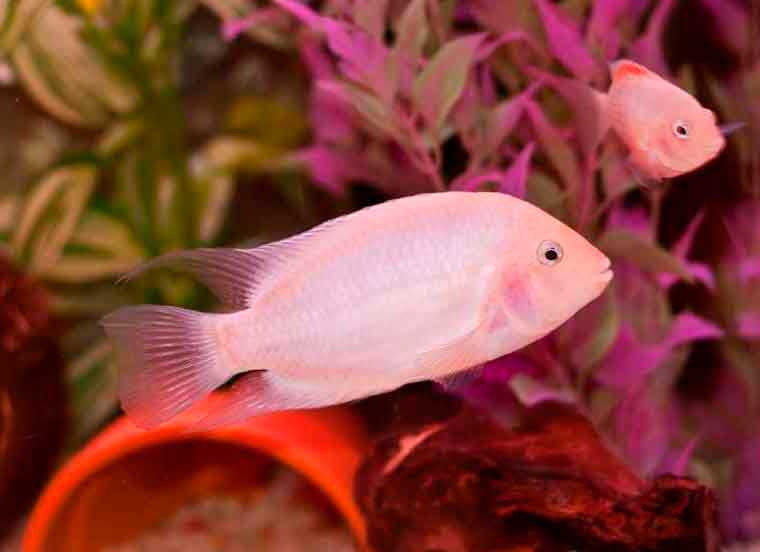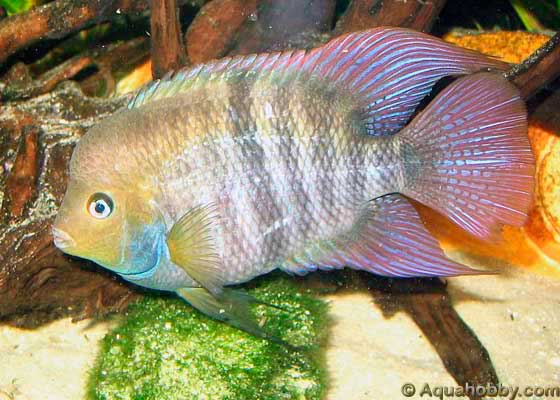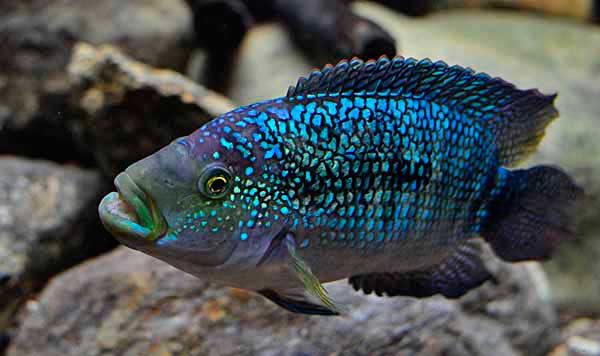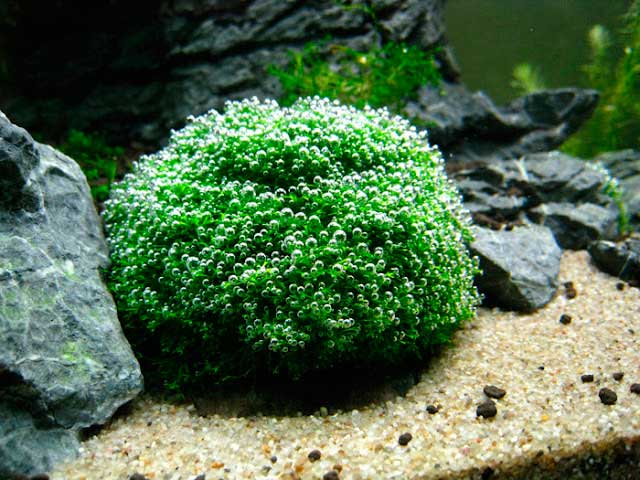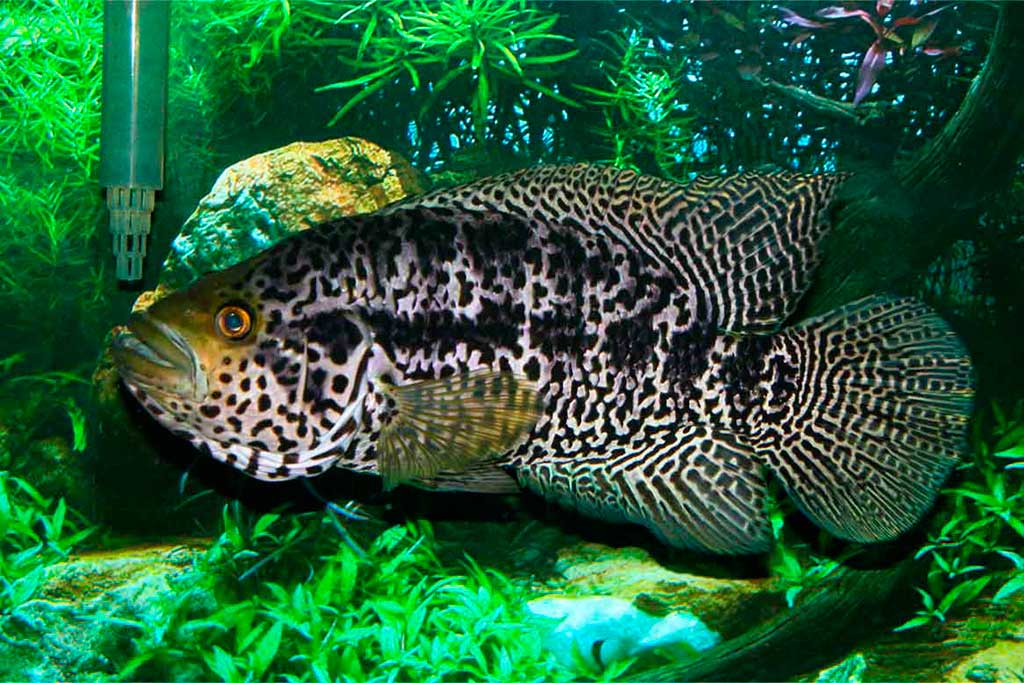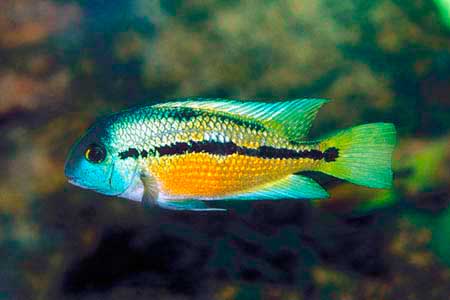Flamingo cichlasoma are amazing aquarium fish in many ways. Their size will allow you to use relatively small containers for their maintenance. Their coloring attracts attention. And the desire to solve the mystery of their origin can make you do genetics.
| classification | |
|---|---|
| kingdom | Animals |
| Type | Chordates |
| Class | Radiant fish |
| Squad | Perch |
| Family | Cichlids |
| Rod | Amatitlania |
| View | Amatitlania nigrofasciata var flamingo |
Synonyms, names in other languages: C. nigra albino, C. pink, C. white
Habitat.: Guatemala. More often occurs under the water surface of lakes Amatitlan, Atitlan; Honduras, Nicaragua, Panama, Costa Rica.
Cichlasoma flamingo description
Cichlasoma flamingo – aquarium fish, which may well be considered another mystery of modern aquaristics. It is enough to read once again the list of synonyms of the name of this species to make sure that there is still no consensus among aquarists about what it really is.
Many authors consider it an albino form of the black-banded cichlasoma. With all due respect to them I can not agree with this. Albinos are completely deprived of the ability to produce coloring pigment. The result is that all parts of their body are discolored. This variant does. Consider its eyes. The fish we are describing has eyes colored with pigment, they are black in color. Whereas in albinos, the eyes are red. The body of the individual has different shades of pink from almost white to cream. This also indicates pigment production. An albino could also have pink coloring, for example, due to the lack of pigment masking of blood vessels, but then all individuals would be approximately the same color. And so identical that the human eye, most likely, would not notice the differences.
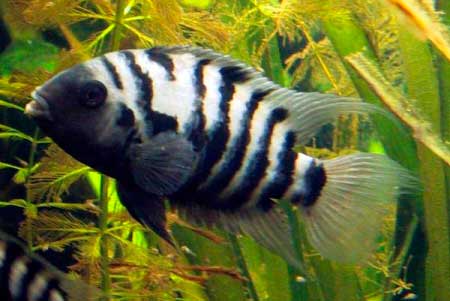
In addition to lengthy arguments about color, we can also lengthily speculate about size. Albinos differ from their normally colored counterparts only in color, or rather its complete absence. As a rule, discolored forms have the same size as individuals that have a normal level of pigment production. White cichlasoma is smaller than blackstripes by half.
Flamingo cichlasoma Albino or mutation?
Why did I call the previous paragraph a lengthy reasoning? Yes, because an experienced amateur cichlazomas will point out to me that black-striped cichlasoma in aquarium keeping is also rarely grows more than 10 centimeters. Whereas in nature, representatives of this species can reach 15 centimeters.
In addition, albinism is much rarer in nature than we can observe in this species.
Therefore, I dare say – the flamingo cichlasoma is not an albino blackstriped cichlasoma.
What then is she?
Anyway, most authors, aquarium practitioners say that the white cichlasoma belongs to the species Cichlasoma nigrofasciatum. What is this affiliation? Where does this certainty come from? Is it a hybrid like flaver horn? Is it the result of long persistent selection? Is it a gene mutation, manifested phenotypically new coloration as in the case of cichlasoma eight-striped and its recessive form – Electric Blue Dempsey?
Whether genetic studies have been conducted on these two fish species I am not aware of.
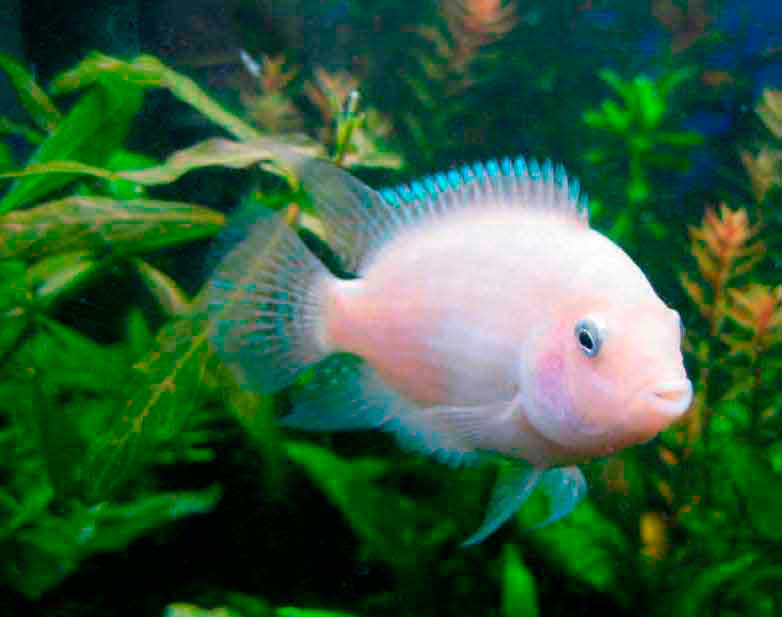
But there is no smoke without fire. From here it follows that either the black-striped cichlasomas in the brood sometimes appear pink forms, or in the “albinos” sometimes takes over the gene striped coloration, then pink dad and mom give birth to striped babies. And if that’s the case, then we’re dealing with a gene mutation. Like the Blue Dempsey mentioned here. Only if the blue variation of C. octopositae still carries infertility of males, as well as weakening of the immune system, especially in the early stages of development, the pink color of C. nigra only reduces the size of its carrier (well, at least from the signs that we can see and realize). So even if the gene is recessive, this color variation is quite viable. In addition, it has one important trait that helps its carriers thrive – the coloration of this varietal is liked by humans.
Not a hybrid or albino!
Поэтому, исходя из выше изложенного, можно утверждать – фламинго не является гибридом или альбиносом. Это естественная мутация. Ген, который за нее ответственен, скорее всего, рецессивный. Он не ухудшает способности мутанта к размножению. Поэтому нам остается только поблагодарить тех наблюдательных аквариумистов, которые заметили эту мутацию, сделав все возможное, чтобы она не затерялась в дебрях генетического кода при следующих нерестах рыбок, имеющих цвет одноименных пернатых.
To summarize: We are dealing with Cichlasoma nigrofasciatum var. Flamingo.
Correct me if I am wrong. I will gladly accept your point of view if I find it sufficiently reasoned.
However, we got carried away with speculations about the origin of the fish, forgetting about the fish itself. Let’s fix that.
Let’s continue with the description 🙂
So, the shape of the body and fins is not much different from other representatives of the genus. It stands out from the general range of its size – perhaps it is the most miniaturized species of cichlazom contained now behind the aquarium glass. Its size rarely exceeds 8 centimeters in length. The color varies from almost white to all shades of pink. Due to this coloration, the fish received such names as “white”, “albino”, “pink”. The same color gave it, perhaps, the most beautiful, in my humble opinion, the name – flamingo.
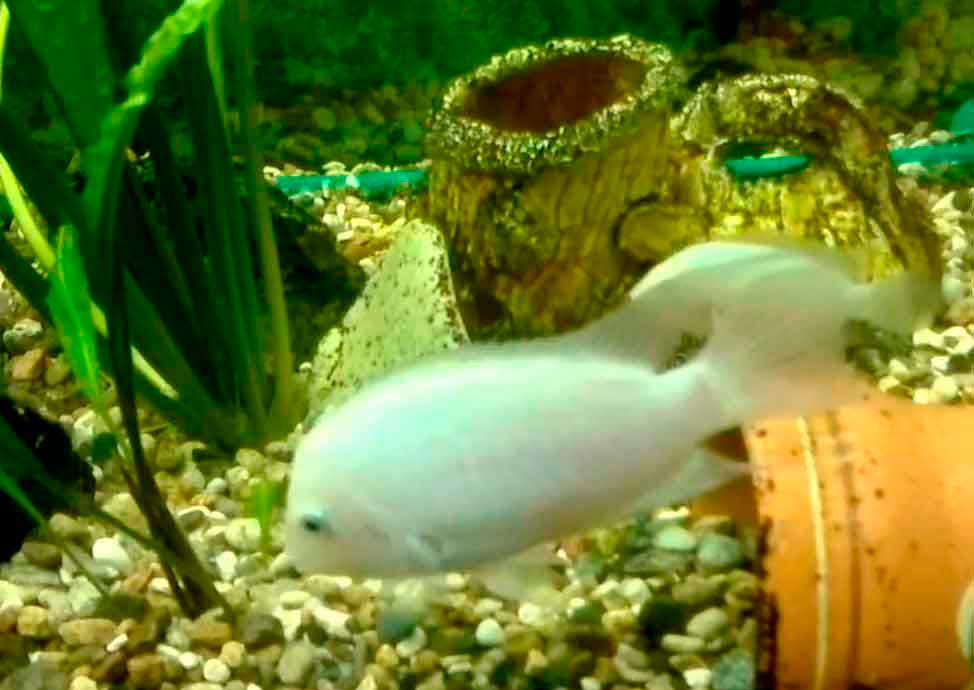
Различия полов
Sexual maturation occurs around one year of age. By this time, males reach larger sizes than females. And the latter acquire a more attractive bright coloration. Their sides are studded with pink pearlescent glitter. In addition, as in other representatives of the genus during spawning appear anal tubercles. The male has a pointed gonopodium. In the female it has the form of a truncated pyramid.
Cichlasoma flamingo content
Относительно простое.
Volume of the aquarium: Due to the relatively small size for the maintenance of a pair of these fish is sufficient fifty-liter tank.
Soil: You can use small gravel, small pebbles. Sand should not be used as a substrate for these fish. The bottom should be decorated with grottoes, rocks, caves of large stones. When marking the bottom, it is necessary to remember about the division of the bottom into several zones, divided by “archipelagos” of stones or thickets of plants.
Plants: The eternal problem of our aquariums – the coexistence of cichlids with representatives of flora in this case is less acute. Of course, white specimens also like to pore the soil, digging up all the plants that man so thoughtlessly from their point of view planted on their territory. But nevertheless, with the selection of plants that have a well-developed root system, as well as skillful masking of the planting site with large stones, you have a chance to admire these fish surrounded by living greenery.
Water parameters are the same as for keeping Cichlsoma nigrofasciatum.
The lighting should be matched to the needs of the plants that will take root next to your underwater flamingo specimens. They themselves do not care much about the intensity of the light. As long as there was no total darkness or direct sunlight. The best option, which feel good most aquarium plants and which will win the color of fish, will be lighting fluorescent lamps with a total power of 0.3-0.5 W / L.
Don’t forget the filtration
Need powerful filtration both mechanical and biological. However, if the aquarium will be more than a hundred liters for a couple, you can try to do without a biological filter. It will only need to regularly change one-third of the water fresh water fresh tempered of the same temperature every week. Here aeration should be provided for sure. It should work at least periodically. Two to three hours before bedtime and two to three hours in the morning, depending on the compressor capacity.
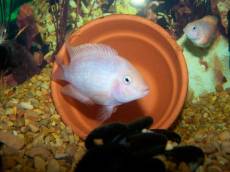
Many authors consider this species to be peaceful. Yes, flamingo cichlasoma – peaceful aquarium fish as well as their blackbanded brethren until they begin to reproduce. And since they can breed when they reach the age of one year old for the entire spring and summer period, it is better to evacuate them at this time for the safety of the neighbors. Cichlasoma after all. Try to keep this in mind. Their maternal and paternal instincts are transformed into strong aggression towards anyone who is not their eggs or fry. Anything that moves while fitting in their mouths can be eaten. The rest will be cornered or beaten to a pulp.
What to feed?
There are no problems with nutrition. You can feed large moths, earthworms, tubeworms, just remember about precautions. Delicacy for them can become small insects. If you value your neon, guppies or shrimp, it is not worth checking whether they will get along with cichlasomes or not. Even if the latter have a poetic name – flamingos.
Breeding is not difficult. It practically does not differ from that of C. nigrescens.
But dare I remind you, this is a color variation, not a mature species. Therefore, you can not keep them with fish with dominant coloration (having black stripes). It is also desirable to select for spawning the most beautiful and healthy individuals.
It should also be remembered that, like their dominant color form individuals carrying recessive color genes are monogamous. Having formed a pair, being still fry, they remain faithful to their mate almost all their lives. If there will be a need to create a pair of very beautiful producers, you can try to break their natural attachments, but no one will give you a guarantee that your attempt will succeed.
Given the increased aggressiveness during spawning, it is better to allocate them a separate living space during the spawning period (approximately from May to September).
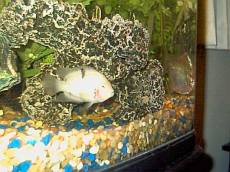
Spawning is stimulated by increasing water temperature by 2 degrees Celsius, as well as replacing one-third of the water with freshly tempered, heated to the same temperature as in the aquarium.
Cichlasoma flamingo Spawning
Having chosen a pebble, the female lays about three hundred eggs on it. And the male fertilizes them. After the fulfillment of conjugal duty, the male enters the post to protect the clutch and surrounding areas. And the female takes care of the eggs. Sometimes their fear for the offspring can reach such limits that they can fight with each other if one of them seems that the other is not properly educating the younger generation. They must have learned that from humans. If this happens, it is better to remove the male, leaving the female to take care of the offspring.
After a few days, the fry will swim. When this happens, it is desirable to start feeding them. The first day, two – infusoria. Next – Artemia nauplii. As they grow, the fry should be transferred to a larger container and feed larger feeds.
Cichlasoma flamingo can be the first fish for the novice aquarist who decided to get acquainted with the amazing family of cichlids.
